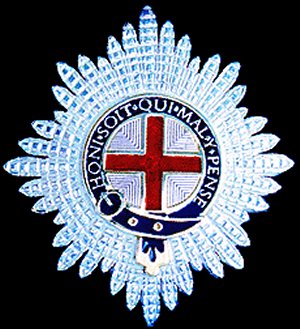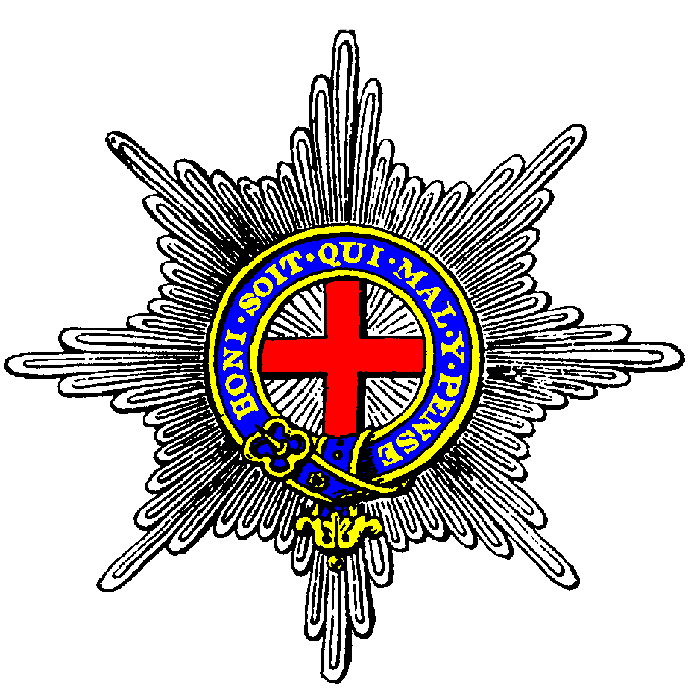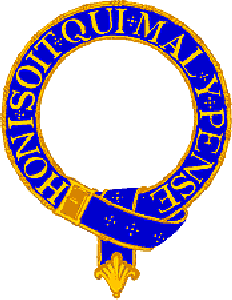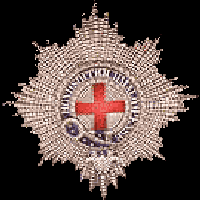Chapter Four
Regalia of Orders

The Order of the Blue Garter
http://www.churchill-society-london.org.uk/garter.html
It was the warrior-classes of the 11th and 12th centuries who first
developed the medieval notion of knighthood and chivalry. The Crusades
in the Middle East had released these men from the constraints of feudalism,
and they expressed their new-found identity by the creation of military
and religious orders of chivalry. The earliest orders were fraternities
of like-minded men, drawn from a particular social class and bound together
in a common purpose. Although still modelled on humanitarian and egalitarian
principles, the later orders were fundamentally elitist. Loyal service
to the monarch could bring the supreme reward of membership to such organisations
and pre-eminent amongst them was, and still is, the Most Noble Order of
the Garter.
 Of the origin of the Most Noble Order we know little. According to its
historian, Elias Ashmole, it commemorated an occasion when King Edward
III of England had "given forth his own garter as the signal for a battle,"
which Ashmole takes to be Crécy. A better-known theory associated
the foundation of the Garter with a trivial mishap at a Court function,
when the Fair Maid of Kent dropped a garter which the King, to cover her
embarrassment, picked up and bound on his own leg, remarking, "Honi Soit
qui Mal y Pense" - "Shame to him who thinks ill of it." This fable appears
to have originated in France and was, perhaps, invented to bring discredit
on the Order. There is a natural unwillingness to believe that the World's
foremost Order of Chivalry had so frivolous a beginning, and we may more
readily accept Froissart's account, who tells us:
Of the origin of the Most Noble Order we know little. According to its
historian, Elias Ashmole, it commemorated an occasion when King Edward
III of England had "given forth his own garter as the signal for a battle,"
which Ashmole takes to be Crécy. A better-known theory associated
the foundation of the Garter with a trivial mishap at a Court function,
when the Fair Maid of Kent dropped a garter which the King, to cover her
embarrassment, picked up and bound on his own leg, remarking, "Honi Soit
qui Mal y Pense" - "Shame to him who thinks ill of it." This fable appears
to have originated in France and was, perhaps, invented to bring discredit
on the Order. There is a natural unwillingness to believe that the World's
foremost Order of Chivalry had so frivolous a beginning, and we may more
readily accept Froissart's account, who tells us:
 "The King of England took pleasure to new re-edify the Castle of Windsor,
the which was begun by King Arthur, and there first began the Table Round,
whereby sprang the fame of so many noble knights throughout all the World.
Then King Edward determined to make an Order and a Brotherhood ….. to be
called Knights of the Blue Garter, and a feast to be kept yearly on St.
George's Day."
"The King of England took pleasure to new re-edify the Castle of Windsor,
the which was begun by King Arthur, and there first began the Table Round,
whereby sprang the fame of so many noble knights throughout all the World.
Then King Edward determined to make an Order and a Brotherhood ….. to be
called Knights of the Blue Garter, and a feast to be kept yearly on St.
George's Day."
 So the Order may have been intended as a revival of the mythical Round
Table. King Edward and his court certainly revelled in the ethos of the
Arthurian tales. Pageants, including jousting tournaments, became known
as 'Round Tables' and knights even met around circular tables like that
still to be seen at Winchester. The informal creation of such an order
of knights, after the great tournament at Windsor in 1344, appears to have
led to the formal instigation of the Order a few years later. The exact
date is controversial, as records are not extant, but St. George's Day
1348 seems likely. The members consisted of twenty-four knights, the monarch
and the Prince of Wales. The two latter are always included; whilst women
have been eligible since early times. St. George has always been the society's
patron and their home is the Collegiate Chapel Royal of St. George in Windsor
Castle, Their heraldic stall plates, dating back to 1390, and colourful
banners are still displayed there today.
So the Order may have been intended as a revival of the mythical Round
Table. King Edward and his court certainly revelled in the ethos of the
Arthurian tales. Pageants, including jousting tournaments, became known
as 'Round Tables' and knights even met around circular tables like that
still to be seen at Winchester. The informal creation of such an order
of knights, after the great tournament at Windsor in 1344, appears to have
led to the formal instigation of the Order a few years later. The exact
date is controversial, as records are not extant, but St. George's Day
1348 seems likely. The members consisted of twenty-four knights, the monarch
and the Prince of Wales. The two latter are always included; whilst women
have been eligible since early times. St. George has always been the society's
patron and their home is the Collegiate Chapel Royal of St. George in Windsor
Castle, Their heraldic stall plates, dating back to 1390, and colourful
banners are still displayed there today.
MORE
|





